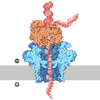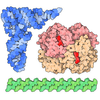+ Open data
Open data
- Basic information
Basic information
| Entry | Database: PDB / ID: 9cnz | ||||||
|---|---|---|---|---|---|---|---|
| Title | Structure of BAM complexed with PTB2 ligand in detergent | ||||||
 Components Components |
| ||||||
 Keywords Keywords | MEMBRANE PROTEIN / protein structure / circular peptide | ||||||
| Function / homology |  Function and homology information Function and homology informationBam protein complex / Gram-negative-bacterium-type cell outer membrane assembly / protein insertion into membrane / cell outer membrane / protein-macromolecule adaptor activity / cell adhesion / identical protein binding / membrane Similarity search - Function | ||||||
| Biological species |  synthetic construct (others) | ||||||
| Method | ELECTRON MICROSCOPY / single particle reconstruction / cryo EM / Resolution: 3.1 Å | ||||||
 Authors Authors | Sun, D. / Tegunov, D. / Payandeh, J. | ||||||
| Funding support | 1items
| ||||||
 Citation Citation |  Journal: Nat Commun / Year: 2024 Journal: Nat Commun / Year: 2024Title: The discovery and structural basis of two distinct state-dependent inhibitors of BamA. Authors: Dawei Sun / Kelly M Storek / Dimitry Tegunov / Ying Yang / Christopher P Arthur / Matthew Johnson / John G Quinn / Weijing Liu / Guanghui Han / Hany S Girgis / Mary Kate Alexander / Austin K ...Authors: Dawei Sun / Kelly M Storek / Dimitry Tegunov / Ying Yang / Christopher P Arthur / Matthew Johnson / John G Quinn / Weijing Liu / Guanghui Han / Hany S Girgis / Mary Kate Alexander / Austin K Murchison / Stephanie Shriver / Christine Tam / Hiroshi Ijiri / Hiroko Inaba / Tatsuya Sano / Hayato Yanagida / Junichi Nishikawa / Christopher E Heise / Wayne J Fairbrother / Man-Wah Tan / Nicholas Skelton / Wendy Sandoval / Benjamin D Sellers / Claudio Ciferri / Peter A Smith / Patrick C Reid / Christian N Cunningham / Steven T Rutherford / Jian Payandeh /   Abstract: BamA is the central component of the essential β-barrel assembly machine (BAM), a conserved multi-subunit complex that dynamically inserts and folds β-barrel proteins into the outer membrane of ...BamA is the central component of the essential β-barrel assembly machine (BAM), a conserved multi-subunit complex that dynamically inserts and folds β-barrel proteins into the outer membrane of Gram-negative bacteria. Despite recent advances in our mechanistic and structural understanding of BamA, there are few potent and selective tool molecules that can bind to and modulate BamA activity. Here, we explored in vitro selection methods and different BamA/BAM protein formulations to discover peptide macrocycles that kill Escherichia coli by targeting extreme conformational states of BamA. Our studies show that Peptide Targeting BamA-1 (PTB1) targets an extracellular divalent cation-dependent binding site and locks BamA into a closed lateral gate conformation. By contrast, PTB2 targets a luminal binding site and traps BamA into an open lateral gate conformation. Our results will inform future antibiotic discovery efforts targeting BamA and provide a template to prospectively discover modulators of other dynamic integral membrane proteins. | ||||||
| History |
|
- Structure visualization
Structure visualization
| Structure viewer | Molecule:  Molmil Molmil Jmol/JSmol Jmol/JSmol |
|---|
- Downloads & links
Downloads & links
- Download
Download
| PDBx/mmCIF format |  9cnz.cif.gz 9cnz.cif.gz | 302 KB | Display |  PDBx/mmCIF format PDBx/mmCIF format |
|---|---|---|---|---|
| PDB format |  pdb9cnz.ent.gz pdb9cnz.ent.gz | 238.9 KB | Display |  PDB format PDB format |
| PDBx/mmJSON format |  9cnz.json.gz 9cnz.json.gz | Tree view |  PDBx/mmJSON format PDBx/mmJSON format | |
| Others |  Other downloads Other downloads |
-Validation report
| Summary document |  9cnz_validation.pdf.gz 9cnz_validation.pdf.gz | 1.2 MB | Display |  wwPDB validaton report wwPDB validaton report |
|---|---|---|---|---|
| Full document |  9cnz_full_validation.pdf.gz 9cnz_full_validation.pdf.gz | 1.2 MB | Display | |
| Data in XML |  9cnz_validation.xml.gz 9cnz_validation.xml.gz | 54.3 KB | Display | |
| Data in CIF |  9cnz_validation.cif.gz 9cnz_validation.cif.gz | 83.1 KB | Display | |
| Arichive directory |  https://data.pdbj.org/pub/pdb/validation_reports/cn/9cnz https://data.pdbj.org/pub/pdb/validation_reports/cn/9cnz ftp://data.pdbj.org/pub/pdb/validation_reports/cn/9cnz ftp://data.pdbj.org/pub/pdb/validation_reports/cn/9cnz | HTTPS FTP |
-Related structure data
| Related structure data |  45767MC  9cnwC  9cnxC  9cnyC  9co0C  9co2C M: map data used to model this data C: citing same article ( |
|---|---|
| Similar structure data | Similarity search - Function & homology  F&H Search F&H Search |
- Links
Links
- Assembly
Assembly
| Deposited unit | 
|
|---|---|
| 1 |
|
- Components
Components
-Outer membrane protein assembly factor ... , 5 types, 5 molecules ABCDE
| #1: Protein | Mass: 90643.383 Da / Num. of mol.: 1 Source method: isolated from a genetically manipulated source Source: (gene. exp.)   |
|---|---|
| #2: Protein | Mass: 41918.945 Da / Num. of mol.: 1 Source method: isolated from a genetically manipulated source Source: (gene. exp.)   |
| #3: Protein | Mass: 36875.277 Da / Num. of mol.: 1 Source method: isolated from a genetically manipulated source Source: (gene. exp.)   |
| #4: Protein | Mass: 27858.350 Da / Num. of mol.: 1 Source method: isolated from a genetically manipulated source Source: (gene. exp.)   |
| #5: Protein | Mass: 13530.256 Da / Num. of mol.: 1 Source method: isolated from a genetically manipulated source Source: (gene. exp.)  Gene: bamE, smpA, smpA_1, smpA_2, A5U30_004761, A8502_003118, ACN81_10110, ACU57_00040, AW118_18475, AWP47_02615, B6R15_004158, B6R31_004759, BANRA_01160, BANRA_03480, BE932_10900, BER14_21305, BG944_ ...Gene: bamE, smpA, smpA_1, smpA_2, A5U30_004761, A8502_003118, ACN81_10110, ACU57_00040, AW118_18475, AWP47_02615, B6R15_004158, B6R31_004759, BANRA_01160, BANRA_03480, BE932_10900, BER14_21305, BG944_004822, BGM66_003581, BGZ_03322, BGZ_03360, BJI68_04965, BK292_15180, BK383_10965, BKL28_002039, BTB68_003672, BTQ06_08460, BvCmsKKP061_02391, BvCmsSIP010_01660, BXT93_22155, C0P57_003578, C1Q91_004646, C2121_004298, C2M16_24735, C2R31_001300, C3F40_23815, C9Z68_21235, CF22_004800, CG704_21595, CIG67_05840, CTR35_004191, CV83915_03496, D3C88_33860, D3G36_24940, D4M65_08385, D4N09_18960, D9D43_23135, D9E49_21045, D9J61_07090, DD762_23945, DIV22_27230, DNQ45_01360, DNX30_24630, DS732_19245, DTL43_21605, DU321_24480, E4K51_10685, E5H86_23265, EAI46_08790, EIA08_06590, EIZ93_15710, EN85_004125, EPS76_07565, EPS97_18785, F7F11_01805, F7N46_20005, F9413_21470, F9461_09705, F9B07_09575, FGAF848_35330, FIJ20_21810, FJQ40_23045, FOI11_00120, FOI11_023060, FORC44_1220, FPI65_16365, FPS11_21880, FVB16_18295, FWK02_09415, FZU14_20455, G3V95_09935, G3W53_10490, G4A38_21000, G4A47_01315, G5603_07570, GAI89_21575, GAJ12_00120, GKF66_23890, GNW61_16365, GOP25_24540, GP711_06005, GP954_12740, GP965_16485, GP975_20410, GQA06_18025, GQE86_17925, GQM04_26375, GQM13_06310, GQM21_13515, GQN34_14130, GQW07_17195, GRC73_20465, GRO95_16555, GRW05_07295, GRW24_17075, GRW56_11330, GRW57_07180, GUC01_18130, H0O72_19885, HEP30_021230, HEP34_004240, HHH44_004392, HI055_003787, HIE29_001466, HJQ60_000025, HLX92_22475, HLZ50_20300, HMV95_03275, HV109_05655, HV209_12725, HVV39_05080, HVW04_21950, HVW43_23255, HVY77_06725, I6H00_24640, I6H02_08695, IFB95_001954, J0541_004271, J5U05_003378, JNP96_20865, KV499_004101, NCTC10082_03668, NCTC10089_01217, NCTC10418_01985, NCTC10429_01977, NCTC10764_00459, NCTC10767_02499, NCTC10865_01545, NCTC10974_01452, NCTC11112_07467, NCTC11126_05233, NCTC11181_03422, NCTC11341_01008, NCTC13148_02470, NCTC7922_00773, NCTC7927_01352, NCTC7928_01496, NCTC8009_02711, NCTC8179_06846, NCTC8333_01395, NCTC8500_01302, NCTC8621_00013, NCTC8621_01206, NCTC8622_03288, NCTC8959_02561, NCTC8960_03971, NCTC8985_06038, NCTC9044_00387, NCTC9045_01444, NCTC9073_04671, NCTC9075_01806, NCTC9077_01597, NCTC9081_05698, NCTC9117_01766, NCTC9702_01479, NCTC9706_03490, NCTC9962_00832, NEP60_26680, OGM49_18410, QDW62_06140, RZR61_19225, SAMEA3472112_00955, WR15_13295 Production host:  |
-Protein/peptide , 1 types, 3 molecules GHI
| #6: Protein/peptide | Mass: 2019.381 Da / Num. of mol.: 3 / Source method: obtained synthetically / Source: (synth.) synthetic construct (others) |
|---|
-Details
| Has ligand of interest | Y |
|---|---|
| Has protein modification | Y |
-Experimental details
-Experiment
| Experiment | Method: ELECTRON MICROSCOPY |
|---|---|
| EM experiment | Aggregation state: PARTICLE / 3D reconstruction method: single particle reconstruction |
- Sample preparation
Sample preparation
| Component | Name: BamABCDE complex / Type: COMPLEX / Entity ID: #1-#5 / Source: RECOMBINANT |
|---|---|
| Source (natural) | Organism:  |
| Source (recombinant) | Organism:  |
| Buffer solution | pH: 8 |
| Specimen | Embedding applied: NO / Shadowing applied: NO / Staining applied: NO / Vitrification applied: YES |
| Vitrification | Cryogen name: ETHANE |
- Electron microscopy imaging
Electron microscopy imaging
| Experimental equipment |  Model: Titan Krios / Image courtesy: FEI Company |
|---|---|
| Microscopy | Model: FEI TITAN KRIOS |
| Electron gun | Electron source:  FIELD EMISSION GUN / Accelerating voltage: 300 kV / Illumination mode: FLOOD BEAM FIELD EMISSION GUN / Accelerating voltage: 300 kV / Illumination mode: FLOOD BEAM |
| Electron lens | Mode: BRIGHT FIELD / Nominal defocus max: 1800 nm / Nominal defocus min: 800 nm |
| Image recording | Electron dose: 46 e/Å2 / Film or detector model: GATAN K2 QUANTUM (4k x 4k) |
- Processing
Processing
| CTF correction | Type: PHASE FLIPPING AND AMPLITUDE CORRECTION |
|---|---|
| 3D reconstruction | Resolution: 3.1 Å / Resolution method: FSC 0.143 CUT-OFF / Num. of particles: 181444 / Symmetry type: POINT |
 Movie
Movie Controller
Controller







 PDBj
PDBj




